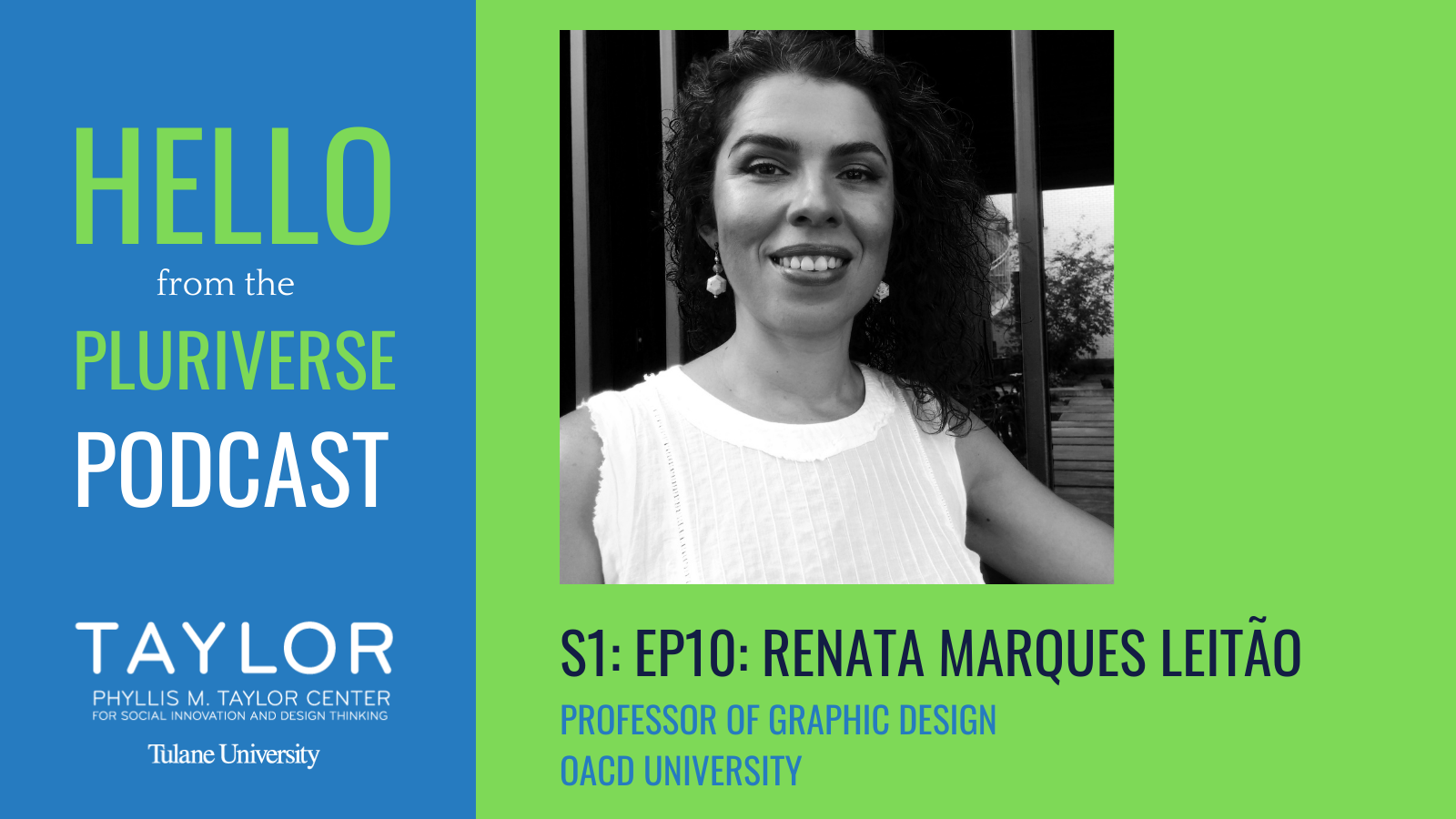“A designer is programming society when they create public images.”
Dr. Renata Marques Leitão is an adjunct professor teaching graphic design at OCAD University in Toronto. Born and raised in Brazil, but formally trained in design in Montreal, Renata’s work is shaped by her upbringing and her training resulting in an identity uniquely her own. After her receiving an education and training that was rooted in European-Anglo standards, Renata has worked to understand how design can reflect and have the power to create culture and social change.
Connect with Dr. Renata Marques Leitão:
Instagram: @renataml
Pluriverse Publication Chapter: Dr. Renata Marques Leitão
Written by Delaney Connor and edited by Michaeline Anglemire
Download a PDF Layout of the Dr. Renata Marque Leitão chapter in the Pluriverse Publication.
Dr. Renata Marques Leitão exudes many qualities that are unique to a designer. She sports stylish, red–framed glasses, talks with her hands, and articulates her ideas using lofty metaphors. Renata grew up in Brazil and remembers realizing that many things were unfair in the world from a young age. She entered university when she was seventeen years old and studied psychology for three years at the Universidade Federal do Paraná, developing an interest in the mechanisms of visual perception. She soon realized that though she loved the study of human cognition, she did not want to become a psychologist. Instead, she fell in love with the transformative power of imagery and decided to redirect her career towards image-making. Renata subsequently attended the Universidade Presbiteriana Mackenzie in São Paulo to study graphic design, hoping to develop technical design skills. In Brazilian, Renata noted, students are educated using the standards of European-Anglo academia, which sparked a curiosity in how identity can shape one’s work.
After working as a designer in Brazil for a few years, Renata moved to Montreal to work on a Master of Design & Complexity from Université de Montréal. She quickly rediscovered an intersection between her design training and her passion for social change. For her graduate research thesis, Renata explored the transformative power of design in impoverished native communities in a project titled Craftsmanship as a Means of Empowerment for the Traditional Communities of Guaraqueçaba: A Case Study.
Renata radiates the kind of worldly wisdom one gains from immersion in a diaspora cultural context. She explained that when one is born in the periphery and moves to North America it is plain that the way we think, conceive, and learn creates assumptions and beliefs. When Renata moved from Brazil to Canada, she gained the perspective that her interpretation of reality was shaped within the context of a developing country. Renata used her cultural position to develop an understanding of how design both reflects and has the power to create culture. Culture affects the operating systems of the brain and characterizes how we interpret small things, how we interact with knowledge, and how we conceive our very reality.
Renata attributes a lot of her cultural wisdom to her six-year project with indigenous Canadian communities through her Environmental Design PhD research. Her thesis, titled Culture as a Project: Design, Self-Determination and Identity Assertion in Indigenous Communities was conducted alongside the Atikamekw people of Quebec. Renata began her involvement with this community as a research assistant focused on product design. Gradually, Renata began to notice that the Atikamekw people’s traditional symbols—those that adorned their baskets, canoes, and clothes—had been slowly replaced by stereotyped, Westernized misconception of indigenous symbols, such as feathers and dreamcatchers. The newest generation of Atikamekw people had become disconnected from the value and meaning of their ancestral symbols. With the help of cultural stewards, Renata utilized graphic design frameworks to develop a methodology of workshops to revitalize their traditions. Her work encouraged elder storytelling about the meaning and value of symbols and promoted intergenerational connection and cooperation. From that point, operating under the principals of graphic design, the Atikamekw people were able to create new and contemporary imagery together. From this project, Renata concluded that history is not merely about looking back; it involves embracing where we come from and using imagery to represent and reflect where we would like to go from here.
When asked about her attitudes towards design thinking, Renata was quick to describe it as a valuable methodology that applies in few specific cases. Using the extended metaphor of a hammer, she explains that certain tools, while valuable, cannot be used ubiquitously in all situations. A hammer is an amazing tool, but sometimes a task requires a screwdriver, and a hammer simply would not suffice. Similarly, in her work with the Atikamekw community, a traditional design thinking approach would not have been successful. There needed to be a gradual approach to understand the aspirations, needs, and goals of the community. Renata believes in the general spirit of design thinking, and that it is useful to keep in mind, even when one cannot apply the exact methodology.
Renata is currently an instructor of graphic design at OCAD University in Toronto and is critical of traditional research and education within her discipline. Broadly, Renata believes that graphic design is a misunderstood profession. She explained that many graphic design students learning skills, but do not often reflect on how their work has the power to influence behavior. In her teaching, Renata seeks to link the basics of graphic design with the realities of the outside world. When asked about advice she has for those interested in using design thinking methods, Renata first established that everyone is born a designer. Early humans wanted to change their reality, so they applied design principles to create tools out of rock. Anyone who uses such processes that require envisioning, seeing, and testing a solution is a designer. Renata believes that an important tenant of design thinking is putting forth the effort to understand how those who are different from us think. Earth is home to countless different identities. As a graphic designer, it is important to find ways to exchange and communicate between these spheres of identity. Finding these intersections is what lays the groundwork for a Pluriverse. Renata concluded that using imagery and storytelling to communicate cross-culturally has the power to generate empathy, compassion, and understanding.
Renata’s unique career in graphic design is informed by her adolescent interest in psychology and rich understanding of cultural differences. In her interview, Renata repeatedly emphasized the power that imagery has to influence society. She asserts that a designer is programming society when they create public images. This notion is not only inspirational; it rings deeply true when one opens their mind to view the world through a designer’s eyes.
- Instagram: @hellopluriverse
- Twitter: @hellopluriverse
- Email: taylor@tulane.edu
- Subscribe to our newsletter
The Hello from the Pluriverse Podcast aims to open up and create a space to have conservations about the pluriversality in design.
This podcast is a project of the Design Thinking for Social Innovation Program at the Phyllis M. Taylor Center for Social Innovation and Design Thinking at Tulane University.
Executive Producer: Lesley-Ann Noel, Ph.D
Sound editing
- Max Esperance
- Lavonte Lucas: xn--vonni-fsa.com, Instagram: @vonnieradass, Twitter: @vonnieradass
Hello from the Pluriverse 2020-2021 Student Team
- Max Esperance – Podcast lead
- Natalie Hudanick and Michaeline Anglemire – Editors
- Tiwani Oseni – Communications
Hello from the Pluriverse 2019-2020 Student Team

